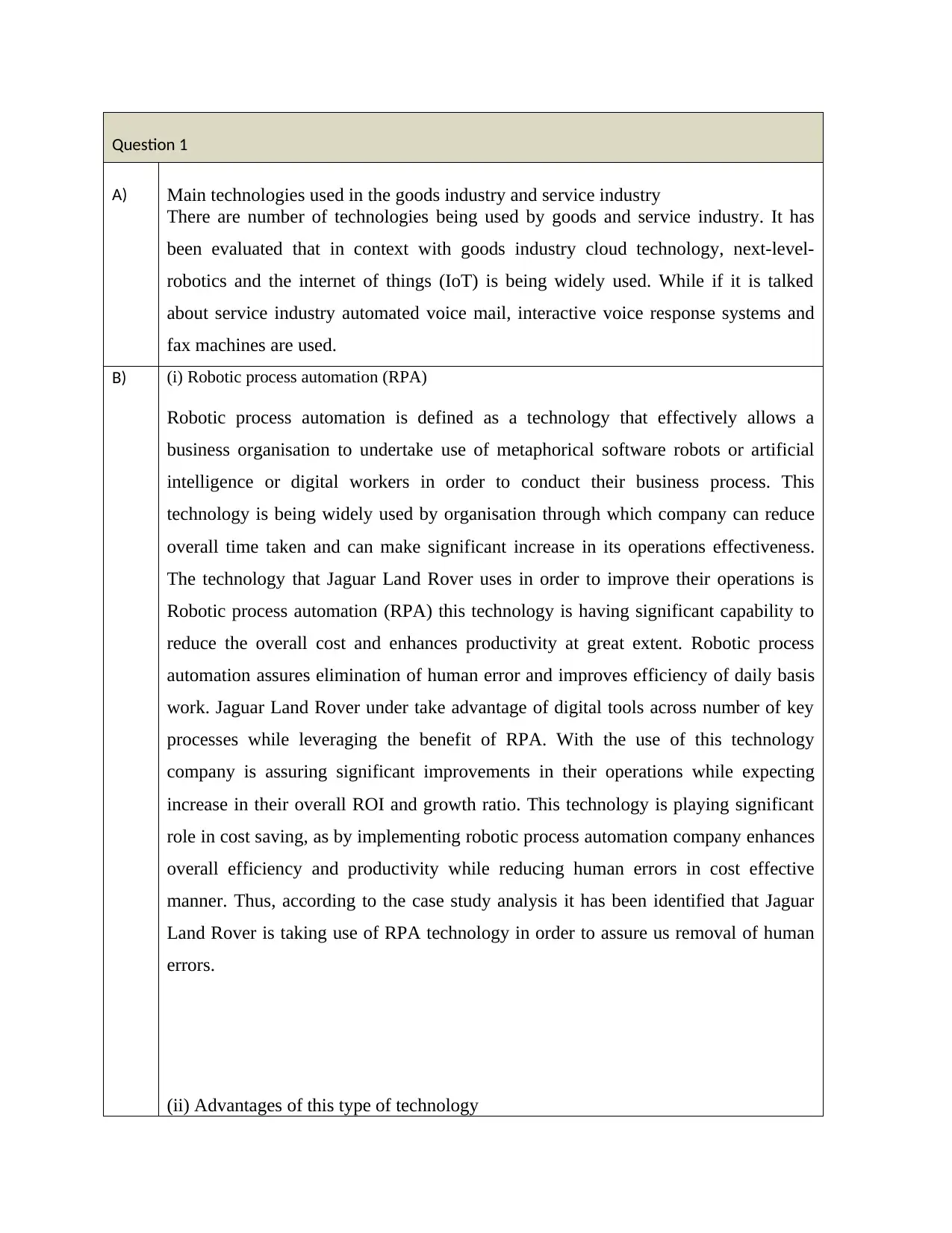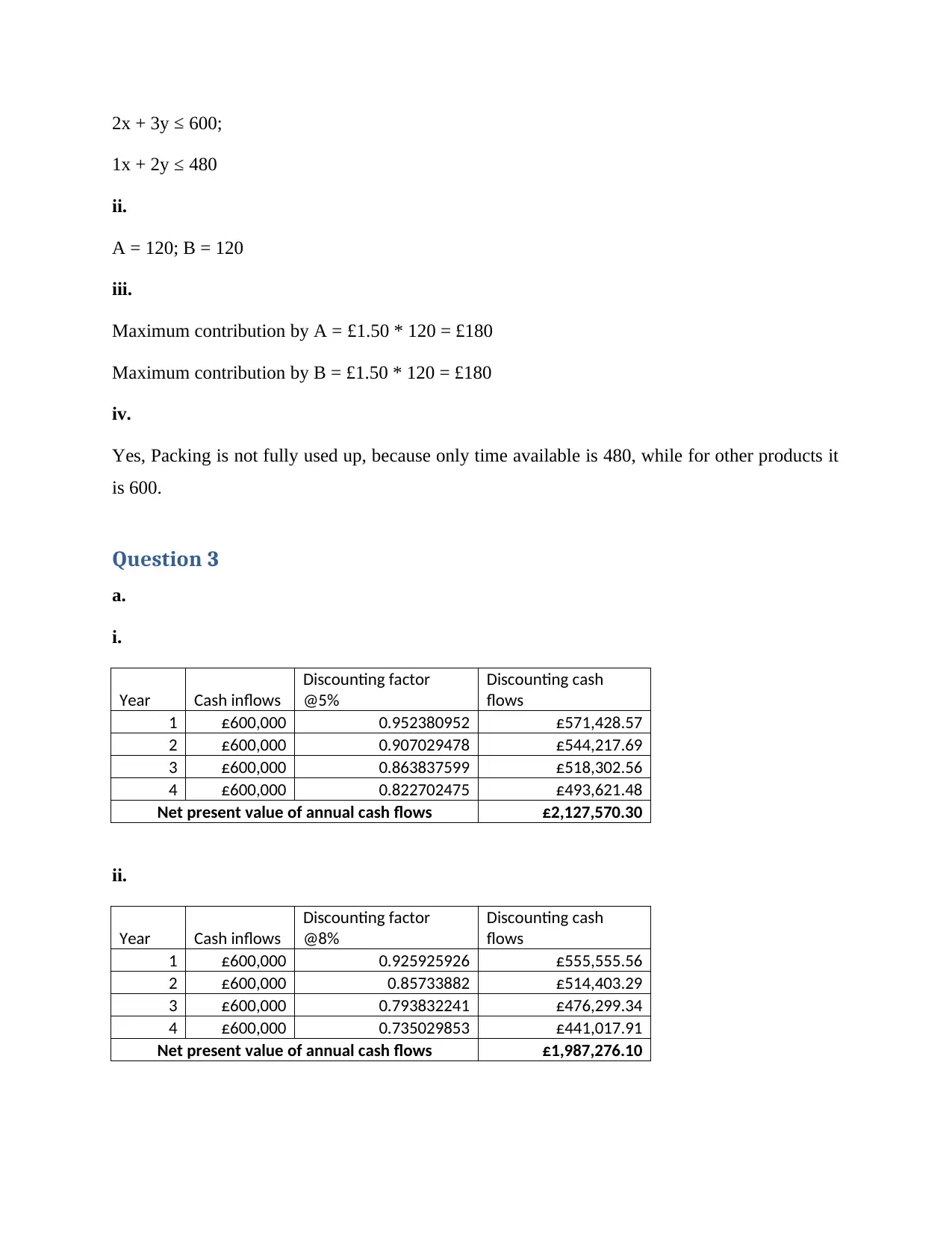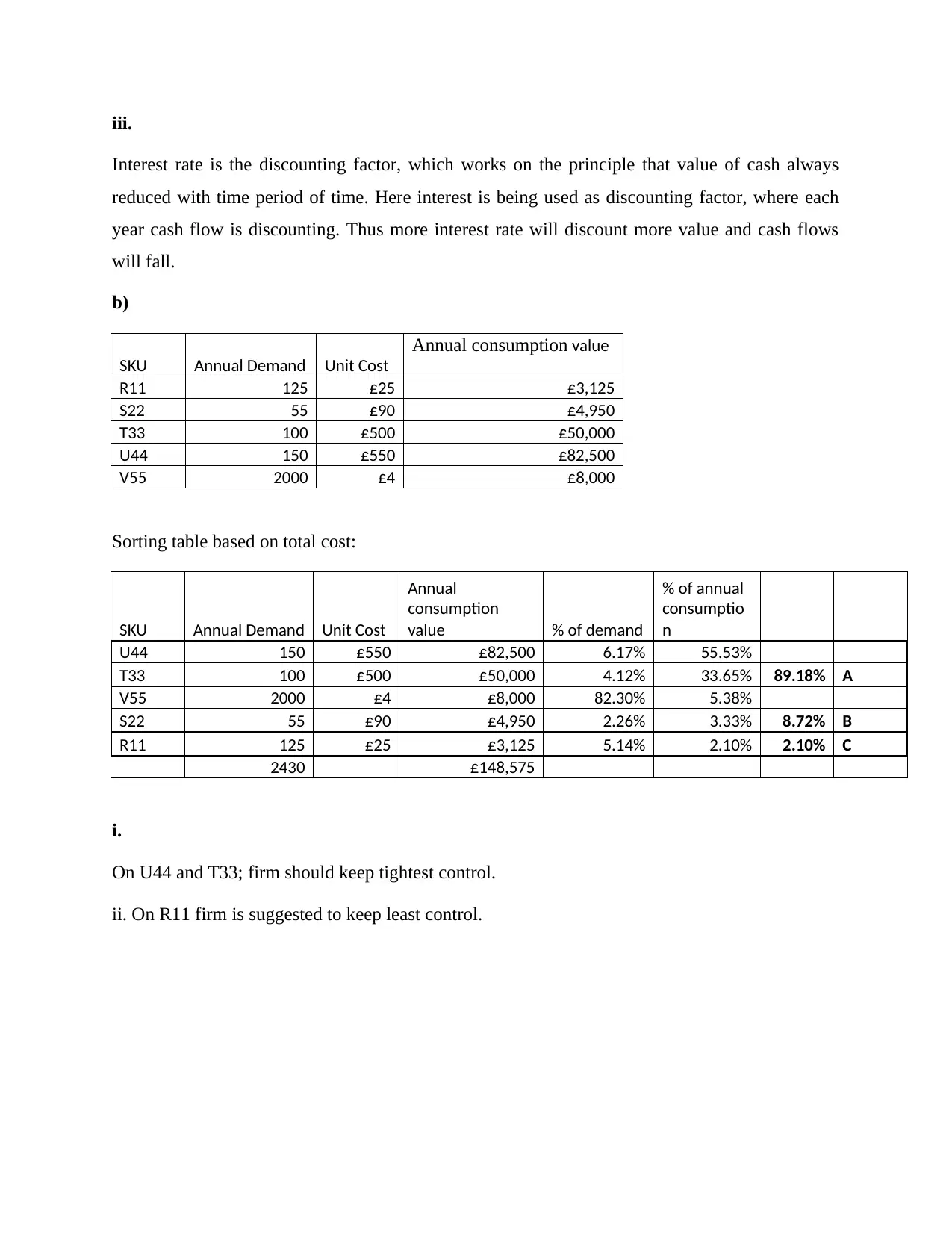Business Development Analysis: RPA Implementation at Jaguar Land Rover
VerifiedAdded on 2022/12/29
|6
|1281
|40
Homework Assignment
AI Summary
This assignment analyzes the implementation of Robotic Process Automation (RPA) at Jaguar Land Rover, exploring the technologies used in the goods and service industries. It defines RPA, its advantages (cost-effectiveness, improved efficiency, and accuracy), and disadvantages (high initial investment, technical skill requirements, and potential job displacement). The analysis includes calculations for bottleneck time and throughput time. Additionally, it covers linear programming problems, net present value calculations, and ABC analysis for inventory management. The document showcases how RPA is used to eliminate non-value-added work and improve operational efficiency, as demonstrated in the Jaguar Land Rover case study, while also addressing various business processes and financial aspects.

Online test
Paraphrase This Document
Need a fresh take? Get an instant paraphrase of this document with our AI Paraphraser

Question 1
A) Main technologies used in the goods industry and service industry
There are number of technologies being used by goods and service industry. It has
been evaluated that in context with goods industry cloud technology, next-level-
robotics and the internet of things (IoT) is being widely used. While if it is talked
about service industry automated voice mail, interactive voice response systems and
fax machines are used.
B) (i) Robotic process automation (RPA)
Robotic process automation is defined as a technology that effectively allows a
business organisation to undertake use of metaphorical software robots or artificial
intelligence or digital workers in order to conduct their business process. This
technology is being widely used by organisation through which company can reduce
overall time taken and can make significant increase in its operations effectiveness.
The technology that Jaguar Land Rover uses in order to improve their operations is
Robotic process automation (RPA) this technology is having significant capability to
reduce the overall cost and enhances productivity at great extent. Robotic process
automation assures elimination of human error and improves efficiency of daily basis
work. Jaguar Land Rover under take advantage of digital tools across number of key
processes while leveraging the benefit of RPA. With the use of this technology
company is assuring significant improvements in their operations while expecting
increase in their overall ROI and growth ratio. This technology is playing significant
role in cost saving, as by implementing robotic process automation company enhances
overall efficiency and productivity while reducing human errors in cost effective
manner. Thus, according to the case study analysis it has been identified that Jaguar
Land Rover is taking use of RPA technology in order to assure us removal of human
errors.
(ii) Advantages of this type of technology
A) Main technologies used in the goods industry and service industry
There are number of technologies being used by goods and service industry. It has
been evaluated that in context with goods industry cloud technology, next-level-
robotics and the internet of things (IoT) is being widely used. While if it is talked
about service industry automated voice mail, interactive voice response systems and
fax machines are used.
B) (i) Robotic process automation (RPA)
Robotic process automation is defined as a technology that effectively allows a
business organisation to undertake use of metaphorical software robots or artificial
intelligence or digital workers in order to conduct their business process. This
technology is being widely used by organisation through which company can reduce
overall time taken and can make significant increase in its operations effectiveness.
The technology that Jaguar Land Rover uses in order to improve their operations is
Robotic process automation (RPA) this technology is having significant capability to
reduce the overall cost and enhances productivity at great extent. Robotic process
automation assures elimination of human error and improves efficiency of daily basis
work. Jaguar Land Rover under take advantage of digital tools across number of key
processes while leveraging the benefit of RPA. With the use of this technology
company is assuring significant improvements in their operations while expecting
increase in their overall ROI and growth ratio. This technology is playing significant
role in cost saving, as by implementing robotic process automation company enhances
overall efficiency and productivity while reducing human errors in cost effective
manner. Thus, according to the case study analysis it has been identified that Jaguar
Land Rover is taking use of RPA technology in order to assure us removal of human
errors.
(ii) Advantages of this type of technology

Robotic process automation (RPA) is significantly enhancing its effectiveness and
uses in number of industries. It is one of the most effective strategic moves which
state the use of intelligent use of resources. This technology free human employee
from liberated task and duly empower them to emphasize upon main objectives of
business. This technology provides number of benefits in terms of generating higher
productivity, standardised task, automate mundane and value with lesser investments.
Use of this technology is significantly gaining popularity as it provides greater
benefits in shorter span of time. Robotic process automation has number of benefits
that make significant increment in improvement in the manual processing hotspot. A
number of advantages associated robotic automation that include cost-effectiveness,
accuracy and quality, consistency, improved analytics, increased consumer
satisfaction, increased employee productivity, versatility better IT support and
management and reconciliation of multiple systems. Robotic process automation
technology significantly allow robot to reduce human efforts. With the use of this
technology organisation can accomplish their objectives in much faster and can
maximize their overall rate of return. This technology effectively helps in improving
efficiency to provide more accurate intelligent data. Furthermore it has been identified
that it provides lower operational risk and significantly improves internal processes
and enhance employee empowerment. In addition to this it has been identified that
with the help of robotic process automation organisation can have better control and
can maintain maximum position and visibility. With the help of this technology
business leaders can undertake effective decisions for the future, as robotic process
automation provide organisation with the ability to analyse, evaluate, track and store
valuable data in an effective manner. With the help of this company can accurately
forecast and developed best practices in short span of time and can significantly
enhance their business growth. According to the analysis it has been identified that
robotic process automation is a revolutionary process that enhances productivity and
efficiency of organisation in an effective manner.
(iii) Disadvantage of the implementation of this technology
In order to implement robotic process automation, organisation is required to make
uses in number of industries. It is one of the most effective strategic moves which
state the use of intelligent use of resources. This technology free human employee
from liberated task and duly empower them to emphasize upon main objectives of
business. This technology provides number of benefits in terms of generating higher
productivity, standardised task, automate mundane and value with lesser investments.
Use of this technology is significantly gaining popularity as it provides greater
benefits in shorter span of time. Robotic process automation has number of benefits
that make significant increment in improvement in the manual processing hotspot. A
number of advantages associated robotic automation that include cost-effectiveness,
accuracy and quality, consistency, improved analytics, increased consumer
satisfaction, increased employee productivity, versatility better IT support and
management and reconciliation of multiple systems. Robotic process automation
technology significantly allow robot to reduce human efforts. With the use of this
technology organisation can accomplish their objectives in much faster and can
maximize their overall rate of return. This technology effectively helps in improving
efficiency to provide more accurate intelligent data. Furthermore it has been identified
that it provides lower operational risk and significantly improves internal processes
and enhance employee empowerment. In addition to this it has been identified that
with the help of robotic process automation organisation can have better control and
can maintain maximum position and visibility. With the help of this technology
business leaders can undertake effective decisions for the future, as robotic process
automation provide organisation with the ability to analyse, evaluate, track and store
valuable data in an effective manner. With the help of this company can accurately
forecast and developed best practices in short span of time and can significantly
enhance their business growth. According to the analysis it has been identified that
robotic process automation is a revolutionary process that enhances productivity and
efficiency of organisation in an effective manner.
(iii) Disadvantage of the implementation of this technology
In order to implement robotic process automation, organisation is required to make
⊘ This is a preview!⊘
Do you want full access?
Subscribe today to unlock all pages.

Trusted by 1+ million students worldwide

heavy investments. These monetary expenses may lead organisation to make major
modifications in their budget. In addition to this, lack of technical ability is also one of
the major disadvantages of RPA, as in order to leverage robotic process automation
organisation is required to implement latest technology in order to reap benefits.
Negligence of this will lead organisation to face heavy losses. In these major changes
is also destructive and can affect company in number of ways. In addition to this
redundancy is also one of the major concern and act as a disadvantage of robotic
process automation, as implementation of this enhances fear among human workers.
In addition to this it has been identified that hiring skilled staff also act as an
disadvantage associated with this technology, as in order to effectively implement
RPA company is required to hire skilled staff those who have sufficient knowledge of
programming and other technical expertise. Thus, according to the above mentioned
analysis it has been identified that potential job losses, initial investment cost, lack of
technical ability, monetary expenses are some of the disadvantage that affects
effective implementation of RPA.
Question2
a.
i. Bottle neck time per batch of this operation is 1 minute per batch in Assembly 1
ii. Throughout time per batch of this operation = 24 + 7 + 3 = 34 minutes per batch
b.
i.
3x + 2y ≤ 600;
modifications in their budget. In addition to this, lack of technical ability is also one of
the major disadvantages of RPA, as in order to leverage robotic process automation
organisation is required to implement latest technology in order to reap benefits.
Negligence of this will lead organisation to face heavy losses. In these major changes
is also destructive and can affect company in number of ways. In addition to this
redundancy is also one of the major concern and act as a disadvantage of robotic
process automation, as implementation of this enhances fear among human workers.
In addition to this it has been identified that hiring skilled staff also act as an
disadvantage associated with this technology, as in order to effectively implement
RPA company is required to hire skilled staff those who have sufficient knowledge of
programming and other technical expertise. Thus, according to the above mentioned
analysis it has been identified that potential job losses, initial investment cost, lack of
technical ability, monetary expenses are some of the disadvantage that affects
effective implementation of RPA.
Question2
a.
i. Bottle neck time per batch of this operation is 1 minute per batch in Assembly 1
ii. Throughout time per batch of this operation = 24 + 7 + 3 = 34 minutes per batch
b.
i.
3x + 2y ≤ 600;
Paraphrase This Document
Need a fresh take? Get an instant paraphrase of this document with our AI Paraphraser

2x + 3y ≤ 600;
1x + 2y ≤ 480
ii.
A = 120; B = 120
iii.
Maximum contribution by A = £1.50 * 120 = £180
Maximum contribution by B = £1.50 * 120 = £180
iv.
Yes, Packing is not fully used up, because only time available is 480, while for other products it
is 600.
Question 3
a.
i.
Year Cash inflows
Discounting factor
@5%
Discounting cash
flows
1 £600,000 0.952380952 £571,428.57
2 £600,000 0.907029478 £544,217.69
3 £600,000 0.863837599 £518,302.56
4 £600,000 0.822702475 £493,621.48
Net present value of annual cash flows £2,127,570.30
ii.
Year Cash inflows
Discounting factor
@8%
Discounting cash
flows
1 £600,000 0.925925926 £555,555.56
2 £600,000 0.85733882 £514,403.29
3 £600,000 0.793832241 £476,299.34
4 £600,000 0.735029853 £441,017.91
Net present value of annual cash flows £1,987,276.10
1x + 2y ≤ 480
ii.
A = 120; B = 120
iii.
Maximum contribution by A = £1.50 * 120 = £180
Maximum contribution by B = £1.50 * 120 = £180
iv.
Yes, Packing is not fully used up, because only time available is 480, while for other products it
is 600.
Question 3
a.
i.
Year Cash inflows
Discounting factor
@5%
Discounting cash
flows
1 £600,000 0.952380952 £571,428.57
2 £600,000 0.907029478 £544,217.69
3 £600,000 0.863837599 £518,302.56
4 £600,000 0.822702475 £493,621.48
Net present value of annual cash flows £2,127,570.30
ii.
Year Cash inflows
Discounting factor
@8%
Discounting cash
flows
1 £600,000 0.925925926 £555,555.56
2 £600,000 0.85733882 £514,403.29
3 £600,000 0.793832241 £476,299.34
4 £600,000 0.735029853 £441,017.91
Net present value of annual cash flows £1,987,276.10

iii.
Interest rate is the discounting factor, which works on the principle that value of cash always
reduced with time period of time. Here interest is being used as discounting factor, where each
year cash flow is discounting. Thus more interest rate will discount more value and cash flows
will fall.
b)
SKU Annual Demand Unit Cost
Annual consumption value
R11 125 £25 £3,125
S22 55 £90 £4,950
T33 100 £500 £50,000
U44 150 £550 £82,500
V55 2000 £4 £8,000
Sorting table based on total cost:
SKU Annual Demand Unit Cost
Annual
consumption
value % of demand
% of annual
consumptio
n
U44 150 £550 £82,500 6.17% 55.53%
T33 100 £500 £50,000 4.12% 33.65% 89.18% A
V55 2000 £4 £8,000 82.30% 5.38%
S22 55 £90 £4,950 2.26% 3.33% 8.72% B
R11 125 £25 £3,125 5.14% 2.10% 2.10% C
2430 £148,575
i.
On U44 and T33; firm should keep tightest control.
ii. On R11 firm is suggested to keep least control.
Interest rate is the discounting factor, which works on the principle that value of cash always
reduced with time period of time. Here interest is being used as discounting factor, where each
year cash flow is discounting. Thus more interest rate will discount more value and cash flows
will fall.
b)
SKU Annual Demand Unit Cost
Annual consumption value
R11 125 £25 £3,125
S22 55 £90 £4,950
T33 100 £500 £50,000
U44 150 £550 £82,500
V55 2000 £4 £8,000
Sorting table based on total cost:
SKU Annual Demand Unit Cost
Annual
consumption
value % of demand
% of annual
consumptio
n
U44 150 £550 £82,500 6.17% 55.53%
T33 100 £500 £50,000 4.12% 33.65% 89.18% A
V55 2000 £4 £8,000 82.30% 5.38%
S22 55 £90 £4,950 2.26% 3.33% 8.72% B
R11 125 £25 £3,125 5.14% 2.10% 2.10% C
2430 £148,575
i.
On U44 and T33; firm should keep tightest control.
ii. On R11 firm is suggested to keep least control.
⊘ This is a preview!⊘
Do you want full access?
Subscribe today to unlock all pages.

Trusted by 1+ million students worldwide
1 out of 6
Related Documents
Your All-in-One AI-Powered Toolkit for Academic Success.
+13062052269
info@desklib.com
Available 24*7 on WhatsApp / Email
![[object Object]](/_next/static/media/star-bottom.7253800d.svg)
Unlock your academic potential
Copyright © 2020–2025 A2Z Services. All Rights Reserved. Developed and managed by ZUCOL.





